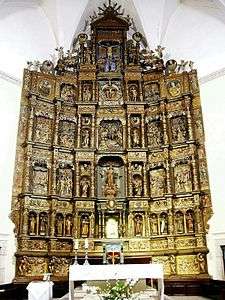Retable

A retable is a structure or element behind and above the altar or communion table of a church. At the minimum it may be a simple shelf for candles behind an altar, but it can be a large structure rising high above.
According to the Getty Art & Architecture Thesaurus Online, "A 'retable' is distinct from a 'reredos'; while the reredos typically rises from ground level behind the altar, the retable is smaller, standing either on the back of the altar itself or on a pedestal behind it. Many altars have both a reredos and a retable."[1] But this distinction may not always be observed. 'Dossal' is another term that may overlap with these; today it usually means an altarpiece painting rising at the back of the altar, to which it is attached, or a cloth hanging, usually on the wall directly behind the altar.
In several foreign languages, such as French (also using 'retable'), the usage is different, usually equating to the English 'reredos' or 'altarpiece', and this often leads to confusion, and incorrect usage in translated texts. The Medieval Latin retrotabulum (modernized retabulum) was applied to an architectural feature set up at the back of an altar, and generally taking the form of a screen framing a picture, carved or sculptured work in wood or stone, or mosaic, or of a movable feature such as the Pala d'Oro in St Mark's Basilica, Venice, of gold, jewels and enamels. The foreign retable is, therefore, what should in English be called a reredos, though that is not in modern usage a movable feature.
The cognate Spanish term, retablo, refers also to a reredos or retrotabulum, although in the specific context of Mexican folk art it may refer to any two-dimensional depiction (usually a framed painting) of a saint or other Christian religious figure, as contrasted with a bulto, a three-dimensional statue of same.
The retable may hold the altar cross, mostly in Protestant churches, as well as candles, flowers and other things.
References
- ↑ Art & Architecture Thesaurus Online 'Retable'
 This article incorporates text from a publication now in the public domain: Chisholm, Hugh, ed. (1911). "article name needed". Encyclopædia Britannica (11th ed.). Cambridge University Press.
This article incorporates text from a publication now in the public domain: Chisholm, Hugh, ed. (1911). "article name needed". Encyclopædia Britannica (11th ed.). Cambridge University Press.
